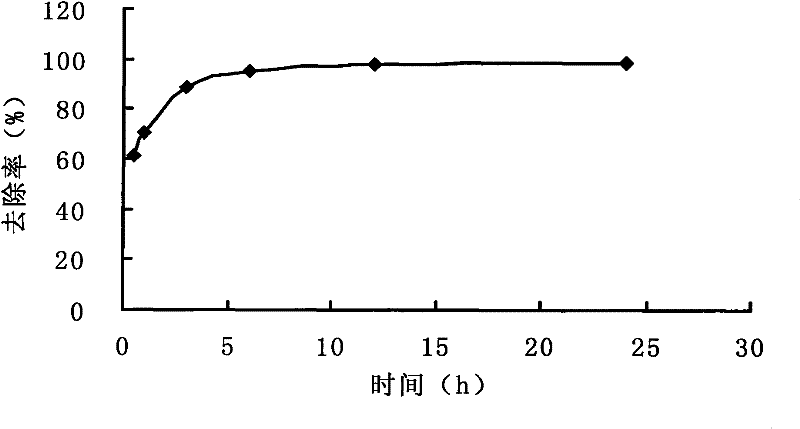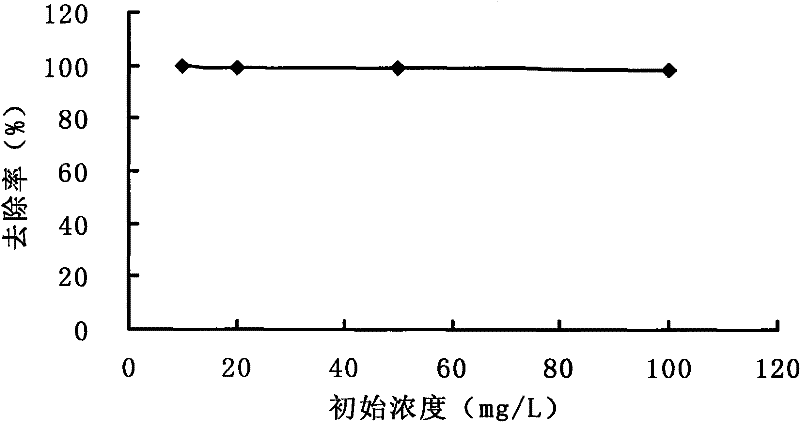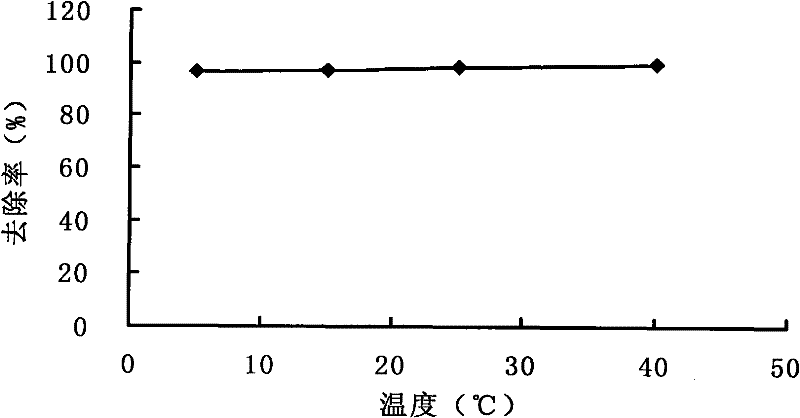Method for treating tetracycline waste water with iron-modified attapulgite adsorbent
A technology of attapulgite and adsorbent, which is applied in the field of adsorption and removal of tetracycline compounds in medical sewage, and achieves the effects of simple operation process, good economic and environmental benefits, and high adsorption efficiency
- Summary
- Abstract
- Description
- Claims
- Application Information
AI Technical Summary
Problems solved by technology
Method used
Image
Examples
Embodiment 1
[0048] Weigh 5g of the purified attapulgite into a 500mL beaker, add 250mL of distilled water, stir magnetically for 0.5h, then add 0.724g of FeCl 3 ·6H 2 O (equivalent to 0.15gFe), magnetic stirring for 30min, to ensure that FeCl 3 ·6H 2 Dissolve O completely, adjust the pH value to 7, continue stirring for 1 hour, centrifuge and wash for 3 times, then dry at 40°C for 36-48 hours, grind to a particle size of ≤100 mesh, and obtain an iron-modified attapulgite adsorbent.
[0049] Accurately weigh 0.1000g (±0.0005g) of the iron-modified attapulgite adsorbent, place it in a 250mL conical flask with a stopper, add 20mL of tetracycline solution with a concentration of 100mg / L, place it in a constant temperature oscillator, and Oscillate at a rate of 150r / min at 25°C, take the supernatant and pass through a 0.45μm microporous membrane at 1h, 3h, 6h, 12h, and 24h respectively, and test the residual tetracycline concentration by liquid chromatography. The groups are parallel, and t...
Embodiment 2
[0052] The iron-modified attapulgite adsorbent was prepared in the same manner as in Example 1.
[0053] Accurately weigh 0.1000g (±0.0005g) of the iron-modified attapulgite adsorbent, place it in a 250mL conical flask with a stopper, add 20mL of tetracycline solutions with concentrations of 10, 20, 50, and 100 mg / L, respectively, and place In a constant temperature oscillator, oscillate at a rate of 150r / min at 25°C for 24h to reach adsorption equilibrium, take the supernatant and pass it through a 0.45μm microporous membrane, and test the concentration of residual tetracycline by liquid chromatography. The groups are parallel, and the results are expressed as arithmetic mean, and the standard deviation is calculated to ensure the test accuracy. After calculation, the adsorption and removal rates of tetracycline were 100.0%, 99.4%, 99.4%, and 98.7%, respectively. attached figure 2 , The effect of the initial concentration of tetracycline on the adsorption removal rate.
...
Embodiment 3
[0056] The iron-modified attapulgite adsorbent was prepared in the same manner as in Example 1.
[0057] Accurately weigh 0.1000g (±0.0005g) of the iron-modified attapulgite adsorbent, place it in a 250mL conical flask with a stopper, add 20mL of tetracycline solution with a concentration of 100mg / L, place it in a constant temperature oscillator, and Oscillate at a rate of 150r / min for 24 hours at 5, 15, 25, and 40°C until the adsorption equilibrium is reached, and the supernatant is passed through a 0.45 μm microporous membrane, and the residual tetracycline concentration is tested by liquid chromatography, with three settings for each experiment. The groups are parallel, and the results are expressed as arithmetic mean, and the standard deviation is calculated to ensure the test accuracy. After calculation, the adsorption and removal rates of tetracycline were 96.6%, 97.4%, 98.7%, and 99.7%, respectively. attached image 3 , the effect of temperature on the adsorption remo...
PUM
 Login to View More
Login to View More Abstract
Description
Claims
Application Information
 Login to View More
Login to View More - R&D
- Intellectual Property
- Life Sciences
- Materials
- Tech Scout
- Unparalleled Data Quality
- Higher Quality Content
- 60% Fewer Hallucinations
Browse by: Latest US Patents, China's latest patents, Technical Efficacy Thesaurus, Application Domain, Technology Topic, Popular Technical Reports.
© 2025 PatSnap. All rights reserved.Legal|Privacy policy|Modern Slavery Act Transparency Statement|Sitemap|About US| Contact US: help@patsnap.com



